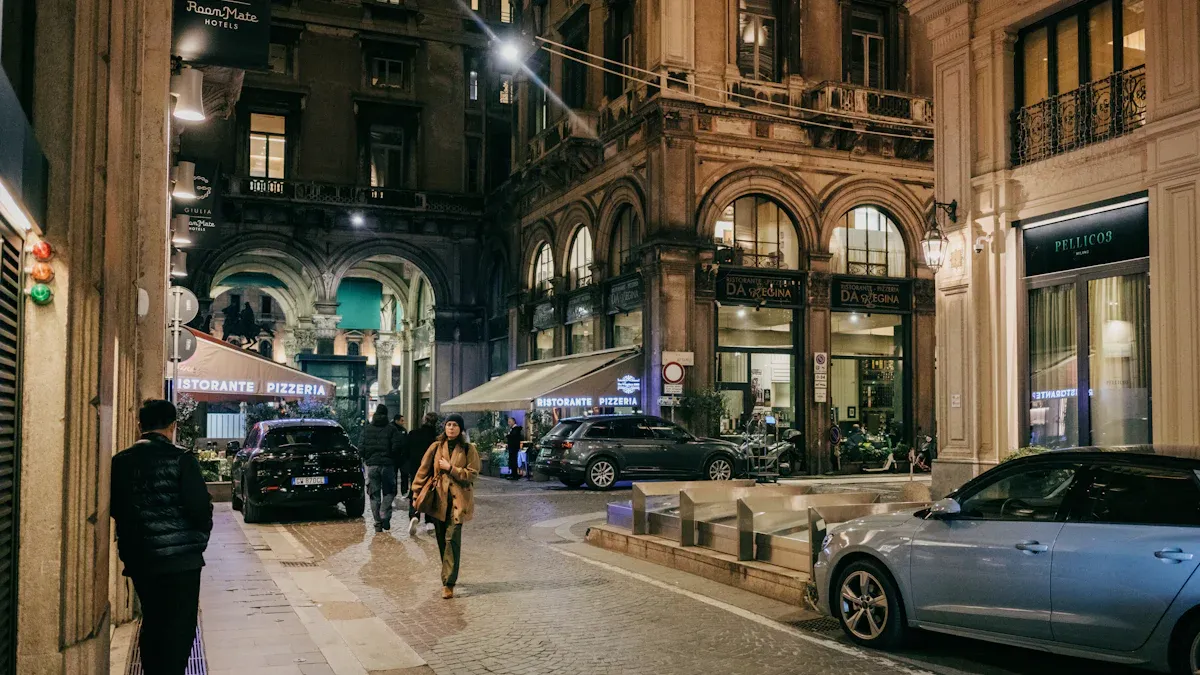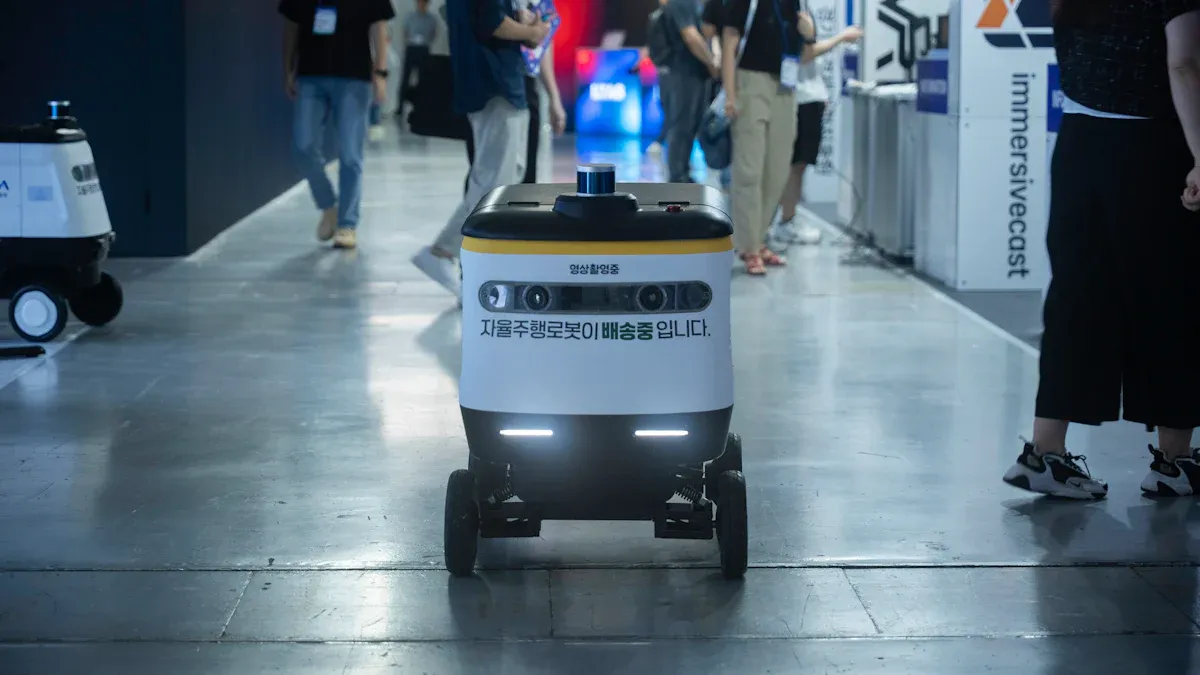Best cities to open robotic convenience stores in Europe

Looking for the best cities to launch your robotic convenience store? Check out London, Berlin, Barcelona, Milan, Zürich, Kamen, Greater Manchester, and Vilnius. Each city stands out for foot traffic, tech adoption, strong tourism, or supportive regulations. You get more chances to succeed when you pick a city with busy streets and smart shoppers.
City choice matters. The right location helps your robotic store thrive and grow fast.
Key Takeaways
Choose cities with high foot traffic like London and Barcelona to maximize customer reach.
Leverage local regulations and support for automation to ensure smooth operations in cities like Zürich and Kamen.
Adopt advanced technology such as AI and robotics to enhance customer experience and operational efficiency.
Stay updated on consumer trends to meet shopper demands for convenience and contactless shopping.
Consider joining local programs for expert advice and support when launching your robotic convenience store.
Best cities for robotic convenience stores

London
You can’t talk about the best cities for robotic convenience stores without mentioning London. The city buzzes with people day and night, making it a prime spot for high foot traffic. You see delivery robots rolling through busy streets more often now. These robots help smaller stores compete with big chains by lowering delivery costs and speeding up service.
London’s push for automation means you get a chance to tap into a growing market.
But you should know that local councils control where robots can go, so you need to check the rules in each area. If the government sets clear laws for delivery robots, you’ll see even more growth in robotic convenience stores.
Delivery robots are becoming common in London’s urban areas.
Robots help small stores compete with larger ones.
Automation makes deliveries more cost-effective.
Local councils negotiate robot use on pavements.
Central government legislation could boost robot deployment.
Council-by-council rules limit robot operations for now.
Berlin
Berlin stands out among the best cities for robotic convenience stores. You find pilot programs and new retail automation tech popping up everywhere. The city’s mix of big department stores and small boutiques gives you plenty of options for testing new ideas. Berlin’s tech infrastructure supports smart store growth, and the retail automation market is set to grow by over 20% each year through 2028.
Berlin leads in retail automation adoption.
High retail density and strong tech support innovation.
Here’s a quick look at Berlin’s consumer trends:
Evidence Type | Description |
|---|---|
Market Growth | Germany has seen 600 smart stores open in six years. |
Consumer Behavior | Cashierless stores are growing fast, showing people like tech in retail. |
Future Potential | Cashierless formats look set to last and expand in the market. |
Barcelona
Barcelona is one of the best cities for robotic convenience stores, especially if you want to tap into tourist traffic. In April 2024, the airport saw 4.6 million passenger movements, up 7.5% from the previous month. Tourist stays in hotels and guesthouses jumped 5.3% year-on-year. Most visitors come from abroad, and they spend a lot on food and drinks—about 50% of their daily budget.
Tourist numbers keep rising, boosting demand for convenience stores.
International visitors spend more, especially on snacks and drinks.
Barcelona’s retail sector is also big on vending and automation. You’ll find smart vending machines with multilingual support and Euro payments. Robotic arms pick products with almost perfect accuracy. Stores use multi-temperature zones for fresh and hot items. IoT modules help you track sales and manage inventory from anywhere. Payment options include cash, cards, mobile, and wearables. Energy-saving designs cut costs and noise.
Innovation Type | Description |
|---|---|
Fully Automatic Vending Machines | Multilingual, Euro payment, smart vending for tourists. |
Robotic Arm System | 99.9% gripping accuracy, handles many products. |
Multi-Temperature Storage | Normal, refrigerated, and heated zones with precise control. |
IoT Management | Remote monitoring and sales data analysis. |
Diversified Payment Methods | Cash, credit, mobile, and wearable payments. |
Energy-Saving Design | Over 40% energy savings, low noise. |
Milan
Milan earns its spot among the best cities for robotic convenience stores thanks to its vending innovation. You see robotic vending machines that do much more than sell snacks. Some brew coffee from beans, others dispense medicine, and some prepare meals in minutes without a microwave. These machines remember what you bought before and offer personalized choices. They run 24/7, so you can grab what you need any time, especially in busy areas.
Robotic vending machines offer custom coffee and meal options.
Pharmaceutical dispensers provide accurate medication delivery.
Machines work all day and night, perfect for high-traffic spots.
Personalized shopping based on your past purchases.
Zürich
Zürich is another top pick for robotic convenience stores. The city is testing automation in food delivery with ‘robo-dogs’ that carry up to 40 liters of food and travel at 15 km/h. These robots make deliveries faster and could soon help convenience stores reach more customers. Zürich’s focus on pilot projects means you get a chance to try new tech before it goes mainstream.
‘Robo-dogs’ deliver food quickly and efficiently.
Automation pilots may expand into retail and convenience stores.
Zürich supports innovation and early adoption.
Kamen
Kamen might surprise you, but it’s making waves in the robotic convenience store scene. The city has launched AI-powered stores that use smart systems to manage inventory and serve customers. You get a chance to test new ideas in a smaller market before scaling up. Kamen’s local support for automation helps you set up and grow your business.
AI-powered stores manage stock and customer service.
Smaller market lets you experiment with new tech.
Local support for automation is strong.
Greater Manchester
Greater Manchester is one of the best cities for robotic convenience stores if you want to reach everyday shoppers. Independent retailers now use affordable AI tools for inventory forecasting and customer service. These tools help small shops predict demand and keep shelves stocked. The In:Five store in Salford uses robotic arms to pick items and runs a click & collect system. Automated stores here operate 24/7, meeting the demand for convenience.
AI tools help shops manage inventory and serve customers.
Robotic arms pick products for click & collect orders.
Stores run all day and night, matching shopper habits.
Shoppers buy about 2.8 items per visit, spending £7.75 each time.
People prefer smaller, frequent shopping trips.
Automated stores predict stock needs and optimize inventory.
Vilnius
Vilnius rounds out the list of best cities for robotic convenience stores. The city leads in robotic delivery and store automation. Autonomous robots from Clevon travel over 2,000 km, delivering goods in all weather. Shoppers give high satisfaction scores and positive feedback. Vilnius was the first in Lithuania to deploy driverless delivery robots, and these robots work on rain, snow, and unpaved roads.
Metric | Value |
|---|---|
Overall Satisfaction Score | 4.8 out of 5 |
Distance Traveled | 2,000 km |
Delivery Efficiency | High |
Customer Engagement | Positive feedback from shoppers |
Autonomous delivery robots operate in tough conditions.
Vilnius was first in Lithuania to use driverless robots.
Shoppers like fast, reliable delivery.
"We believe that these robots will give us a significant advantage in the delivery sector, as customers will receive their goods quickly, even in the city center, and even during peak hours." – Tadas Norušaitis, CEO of LastMile
Regulatory policies in Vilnius have adapted to support autonomous delivery. The city updated its legal framework to fit the needs of robotic vehicles on public roads.
"This is something that all countries are facing – the rules need to be adapted to fit the practicalities of deploying autonomous vehicles on public roads." – Tadas Norušaitis, CEO of LastMile
Key factors for success

Technology
You need strong technology to run a robotic convenience store. Flexible warehouse automation helps you move products quickly. Mobile robots can bring shelves to picking stations, so you do not need fixed setups. This makes your store easy to change and keeps things running smoothly. Automated parcel lockers also help. You can fit them into small spaces, and they make it easy for customers to pick up orders. These lockers boost sales and work well with e-commerce.
Robotics and AI bring big benefits. Take a look at how they help:
Benefit | What It Means for You |
|---|---|
No more waiting in line. Shopping feels faster and less stressful. | |
Increased Operational Efficiency | You save on labor costs. Staff can focus on important tasks instead of checkout. |
Rich Data Insights | You get data on what people buy. This helps you set up your store and plan better. |
Logistics
You face some challenges with logistics in Europe. You need to fit new delivery robots into old systems. People must accept robots on the streets. Your store also needs a strong data network to keep robots working well.
Here are some ways to solve these problems:
Use goods-to-person robots. They cut down walking and make work easier.
Try the HaiPick system. It picks items faster and saves money.
Connect your robots with IoT devices. This lets you track inventory in real time and react quickly.
Regulations
You must follow strict rules when you open a robotic convenience store. Safety comes first. You need to make sure your robots do not hurt anyone. You also have to know who is responsible if something goes wrong. Cybersecurity is important, too. Your devices must protect customer data. New laws, like the General Product Safety Regulation and Ecodesign for Sustainable Products Regulation, set higher standards for safety and the environment.
Regulatory Consideration | Description |
|---|---|
Keep your store safe for everyone. | |
Product Liability | Know your responsibilities for what you sell. |
Cybersecurity Obligations | Protect your connected devices and customer data. |
Governance | Stay on top of rules for autonomous systems. |
General Product Safety Regulation | New rules for AI and robots since December 2024. |
Ecodesign Regulation | Design your products to be easy to fix and good for the planet. |
Consumer trends
You need to watch what shoppers want. People in Europe like stores that offer personal help and smart suggestions. They want robots that remember their choices. New AI and sensor tech make these robots smarter and more fun to use. Retailers now invest in automation to make shopping easier and faster. If you keep up with these trends, your store will stand out in the Best cities for robotic convenience stores.
Market trends in Europe
Autonomous stores
You see more autonomous stores popping up across Europe every year. These stores use robots and smart tech to run with little or no staff. The market for autonomous stores in Europe is now worth about USD 1.1 billion in 2024. You can expect this number to grow fast, with a compound annual growth rate of 31.2% through 2033. That means you will find more stores using robots, sensors, and AI to serve customers quickly and easily.
Autonomous stores use robots to handle checkout and restocking.
You get faster service and fewer lines.
Store owners save money on labor and can stay open 24/7.
If you want to open a robotic convenience store, you are joining a booming market.
AI and automation
AI and automation are changing how you shop in Europe. Many stores now use AI-powered checkout systems. You can grab what you need and pay without waiting for a cashier. Real-time inventory tracking helps stores keep shelves full and cut down on waste. Smart shelves show you products and make shopping easier. Unmanned convenience stores are growing because people want contactless shopping.
Trend Description | Impact |
|---|---|
AI-powered checkout systems | Makes shopping faster and smoother |
Real-time inventory tracking | Keeps products in stock and reduces waste |
Smart shelves | Helps you find what you want quickly |
Unmanned convenience stores | Gives you a safe, contactless shopping experience |
You also see more stores using cloud-based POS systems. By 2025, over 60% of stores will have them. AI video analytics can cut down on theft by up to 35%. Prepared food sales now make up more than 25% of in-store revenue. You get more fresh food options, and stores run better.
AI video analytics reduce shrinkage.
Prepared food brings in more sales.
Cloud-based POS systems are becoming the norm.
Consumer acceptance
You might wonder if shoppers like these changes. The answer is yes. People in Europe want fast, easy, and safe shopping. They like stores that let them pay quickly and avoid crowds. Many shoppers trust robots and AI to help them find what they need. When you open a robotic convenience store, you meet these new needs. You give people more choices and a better shopping experience. 😊
You’ve seen how cities like London, Berlin, and Barcelona offer unique perks for robotic convenience stores. Picking the right city helps you match your goals with local trends. If you want to get started, check out successful models like Sensei’s automated store in Portugal. You can join programs such as Żabka Future Lab for expert advice. Stores like VenHub show you how to cut costs and run 24/7.
Ready to explore? Local research and smart partnerships can help you launch your own robotic store in Europe.
FAQ
How much does it cost to open a robotic convenience store?
You usually need at least $100,000 to get started. Costs cover robots, software, and store setup. Some cities offer grants or tax breaks. You can save money by starting small and adding more robots later.
Do I need special permits for robotic stores in Europe?
Yes, you need permits for robots and automated systems. Each city has different rules. You should check with local authorities before you open your store. Some places make it easier if you join pilot programs.
Will shoppers trust robots in my store?
Most shoppers like robots if they make shopping faster and easier. You can build trust by showing how robots work and keeping everything safe. Friendly staff and clear signs help people feel comfortable.
What technology do I need for a robotic convenience store?
You need smart robots, sensors, and a strong Wi-Fi network. Many stores use AI for checkout and inventory. You can add mobile payment options and security cameras. Good tech keeps your store running smoothly.
See Also
Starting Your AI-Driven Corner Store on a Budget
Understanding the Growth of AI-Enhanced Convenience Stores
The Future of Retail Lies in AI-Driven Stores
